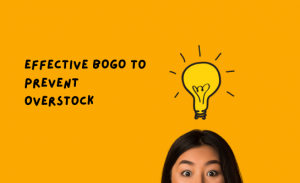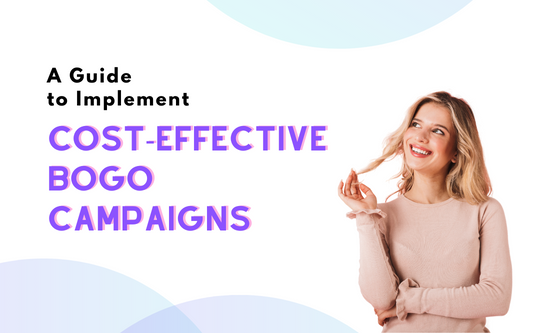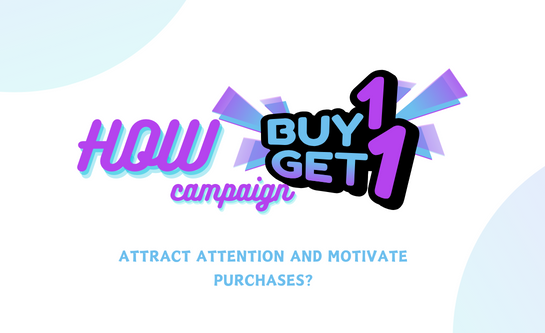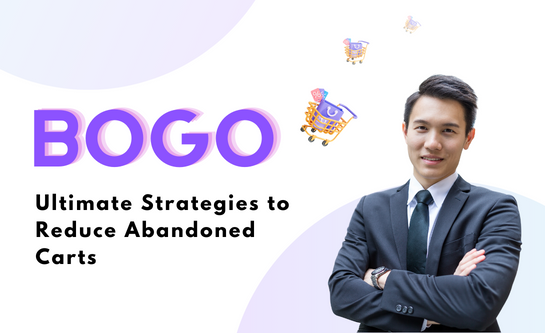Mastering BOGO: Effective Strategies to Prevent Overstock
 Apr 16th, 2024
Apr 16th, 2024
 506 views
6 MINS READ
506 views
6 MINS READ
Buy One Get One (BOGO) promotions have become a staple marketing strategy for retailers across various industries. The allure of BOGO deals lies in their ability to attract customers by offering them perceived value and incentivizing larger purchases. However, without careful planning and execution, BOGO promotions can lead to a significant buildup of inventory, tying up capital and potentially eroding profits. In this article, we delve into effective BOGO strategies aimed at preventing excessive inventory and maximizing the benefits of this popular promotional tactic.
Risks of Overstock

Excess inventory or overstock is the surplus of stock, it happens when the number of stock bought surpasses the stock sold. As Marketing and Logistics have a strong relationship the failure in inventory management also affects marketing performance and vice versa. Let us point out some risks associated with excess inventory:
1. Capital Tie-Up:
Overstock ties up capital that could be allocated to other areas of the business, such as marketing initiatives or product development.
2. Storage Costs:
Holding excess inventory incurs storage costs, including rent for warehouse space and expenses related to inventory management systems. A recent study showed that the cost of carrying overstock could reach 30% of goods’ annual profit. Hence, it is essential to make the right prediction for future demand.
3. Risk of Obsolescence:
Products sitting in inventory for extended periods run the risk of becoming obsolete or outdated, leading to potential write-offs and loss of revenue. In detail, clearance promotions or markdowns may be required to move excess inventory and outdated items, so it leads to decrease of profit margins and eroding profitability.
Causes of Overstock
1. Inaccurate Demand Forecasting:
One of the primary reasons for overstocking is inaccurate demand forecasting. If businesses fail to accurately predict customer demand for certain products, they may end up ordering excess inventory to meet perceived demand, only to find that actual sales fall short. This can occur due to factors such as seasonal fluctuations, changing consumer preferences, or unexpected market trends.
2. Overestimation of Promotion Effectiveness:
While BOGO promotions can drive sales and attract customers, businesses may sometimes overestimate their effectiveness, leading to overstocking. If a BOGO promotion fails to generate the expected increase in sales or if customer response is lower than anticipated, businesses may be left with excess inventory that was ordered in anticipation of higher demand. Overestimating the impact of promotions can result in misalignment between inventory levels and actual sales, ultimately leading to overstocking. So it is vital to measure and estimate the right impact of the promotion campaign. Our ezLoyalty platform could help your business to collect campaign data, measure effectiveness and estimate based on data pool.
3. Poor Inventory Management Practices:
Inefficient inventory management practices can also contribute to overstocking. This includes factors such as inadequate stock monitoring, improper inventory turnover calculations, and suboptimal replenishment strategies. Without robust inventory management systems in place, businesses may struggle to maintain optimal inventory levels and end up with excess stock.
4. Supplier Issues:
Problems with suppliers, such as delayed deliveries, over-ordering, or unexpected changes in product availability, can also lead to excessive inventory. If businesses rely heavily on a single supplier or fail to establish clear communication channels and agreements, they may encounter difficulties in managing inventory levels effectively.
5. Seasonal Variations and Trends:
Seasonal variations and trends in consumer demand can significantly impact inventory levels. Businesses operating in industries with seasonal fluctuations, such as fashion, electronics, or home goods, must carefully manage inventory to avoid overstocking during slow seasons or outdated inventory when trends change. Failure to adapt to seasonal shifts in demand or accurately anticipate emerging trends can result in excess inventory that may become obsolete or difficult to sell.
Effective BOGO Strategies to Avoid Overstock

To harness the benefits of BOGO promotions while mitigating the risks of excess inventory, retailers can implement the following strategies:
1. Understand Your Customer Base
Before launching any BOGO promotion, it’s crucial to understand your target audience’s preferences, purchasing behavior, and spending habits. Analyzing customer data, such as past purchases and demographic information, can provide valuable insights into which products are likely to resonate with your customers. By understanding your customer base, you can tailor your BOGO promotions to offer products that are in high demand, reducing the risk of overstocking less popular items.
2. Set Clear Objectives
Define clear objectives for your BOGO promotion to guide your strategy and measure its success. Whether your goal is to increase sales, clear out excess inventory, or attract new customers, having specific and measurable objectives will help you evaluate the effectiveness of your promotion. By aligning your BOGO strategy with your business objectives, you can ensure that each promotion serves a purpose and contributes to your overall goals.
3. Limit BOGO Offers to Selected Products
Rather than applying BOGO promotions across your entire inventory, focus on specific products or categories that are either seasonal, slow-moving, or have excess stock. For example, you could take advantage of cross-promotion on complementary products, in which offer BOGO deals on a pair of complementary items such as tennis rackets and balls. This strategy would increase the value of each transaction and reduce the risk of overstocking individual items. By limiting BOGO offers to selected items, you can control inventory levels more effectively and prevent overstocking across your entire product range. Additionally, this approach allows you to highlight certain products and create a sense of urgency among customers to take advantage of the offer.
4. Implement Tiered Discounts
Consider implementing tiered BOGO promotions where customers receive increasing discounts based on the number of items purchased. For example, “Buy One, Get One 50% Off” or “Buy Two, Get One Free.” Tiered discounts encourage customers to purchase more items to unlock greater savings, helping to increase average order value while reducing the risk of overstocking. By offering incremental discounts, you can also appeal to different customer segments with varying purchasing preferences.
5. Leverage Data Analytics
Utilize data analytics tools to monitor the performance of your BOGO promotions in real-time and make data-driven decisions. Track key metrics such as sales volume, inventory turnover, and customer engagement to assess the effectiveness of each promotion. Analyzing this data will enable you to identify trends, adjust your strategy accordingly, and optimize future BOGO campaigns to minimize the risk of overstocking. Additionally, consider employing predictive analytics to forecast demand and inventory levels accurately, allowing you to plan BOGO promotions more strategically.
6. Implement Time-Limited Promotions
Create a sense of urgency and encourage immediate action by implementing time-limited BOGO promotions. By setting a clear start and end date for the offer, you can motivate customers to make a purchase before the promotion expires, thereby reducing the likelihood of overstocking. Time-limited promotions also help drive traffic to your store or website within a specified timeframe, generating buzz and excitement around the offer.
7. Optimize Inventory Management
Effective inventory management is essential for successfully executing BOGO promotions without overstocking. Invest in inventory management software that provides real-time visibility into stock levels, reorder points, and sales trends. By maintaining optimal inventory levels and replenishing stock strategically, you can minimize the risk of overstocking while ensuring that you have sufficient inventory to fulfill customer demand during BOGO promotions. Implementing just-in-time inventory practices can also help reduce carrying costs and maximize efficiency.
8. Offer BOGO Promotions Seasonally
Align your BOGO promotions with seasonal trends and consumer shopping behavior to maximize their impact and minimize the risk of overstocking. For example, offer BOGO promotions on winter clothing at the end of the season to clear out excess inventory before spring arrives. By timing your promotions strategically, you can capitalize on peak demand periods while avoiding the accumulation of unsold inventory. Take advantage of major holidays, events, and shopping seasons to drive sales and engage with customers through targeted BOGO promotions.
9. Monitor and Adjust
Continuous monitoring and adjustment are essential for optimizing BOGO strategies and preventing overstock inventory. Regularly evaluate the performance of your promotions, gather customer feedback, and analyze sales data to identify areas for improvement. Be prepared to adjust your approach based on changing market conditions, consumer preferences, and inventory levels. By staying agile and responsive, you can fine-tune your BOGO strategies over time to achieve better results and mitigate the risk of overstocking.
Conclusion
BOGO promotions can be a powerful tool for driving sales and attracting customers, but they also come with the risk of overstocking inventory if not managed effectively. By implementing the strategies outlined above, businesses can strike the right balance between maximizing sales and minimizing the risk of overstocking. By understanding their customers, setting clear objectives, and leveraging data analytics, retailers can execute BOGO promotions strategically to achieve their business goals while maintaining optimal inventory levels. With ezLoyalty platform that carefully plans, monitors, and adjusts, businesses can harness the potential of BOGO promotions to boost revenue and enhance customer satisfaction without falling victim to the pitfalls of overstock inventory.
 Back to blog page
Back to blog page


































